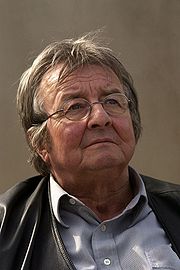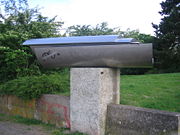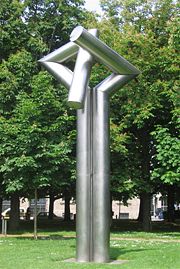
Erich Hauser
Encyclopedia

Life
From 1945 to 1948 Erich Hauser was apprenticed to a steel engraver. Moreover he was taught drawing and modelling by Father Ansgar at the Beuron ArchabbeyBeuron Archabbey
Beuron Archabbey is a major house of the Benedictine Order located at Beuron in the upper Danube valley in Baden-Württemberg in Germany....
.
Afterwards he studied at the Freie Kunstschule in Stuttgart
Stuttgart
Stuttgart is the capital of the state of Baden-Württemberg in southern Germany. The sixth-largest city in Germany, Stuttgart has a population of 600,038 while the metropolitan area has a population of 5.3 million ....
taking evening classes in sculpting.

Pablo Picasso
Pablo Diego José Francisco de Paula Juan Nepomuceno María de los Remedios Cipriano de la Santísima Trinidad Ruiz y Picasso known as Pablo Ruiz Picasso was a Spanish expatriate painter, sculptor, printmaker, ceramicist, and stage designer, one of the greatest and most influential artists of the...
and the Italian-French artist Berto Lardera
Berto Lardera
Roberto Lardera , was a notable Italian sculptor of the 20th Century. He was informally known as Berto Lardera. He was born in La Spezia, Italy, the son of a shipyard worker...
.
In dealing with metal he was influenced by contemporary informel painters of the 1950s. At first his steel sculptures still showed noticeable marks of processing. Later he opted for smooth surfaces.
Since 1962 he worked with industrially pre-fabricated steel plates. At the same time he dealt with basic geometrical structures and technical structural elements, which were characteristic of Hauser’s first autonomous works.
He transformed composed surfaces into hollow sculptures to be viewed from all sides, showing edgy burrs and caves. The sculptures cannot be walked-on. Hauser assembled the metal elements in such a way that they finally became regular hollow bodies. Thus he created spheres, cubes and tetrahedrons.
It is significant of these works that they seem likely to break or fall to pieces or be in risky balance.
Hauser’s participation in the documenta III (1964), documenta 4 (1968) and documenta 6 (1977) in Kassel
Kassel
Kassel is a town located on the Fulda River in northern Hesse, Germany. It is the administrative seat of the Kassel Regierungsbezirk and the Kreis of the same name and has approximately 195,000 inhabitants.- History :...
brought about his artistic breakthrough.
From 1964 to 1965 Hauser was a guest lecturer at the school of visual arts in Hamburg. Since then he frequently used pillars as subjects and discovered spatial height. Since 1967 he made his sculptures from polished metal discs shaped as pipes divided lengthwise. In 1969 he was awarded the renowned prize of the São Paulo Art Biennial
São Paulo Art Biennial
The São Paulo Art Biennial was founded in 1951 and has been held every two years since. It is the second oldest art biennial in the world after the Venice Biennial , which serves as its role model....
.

Akademie der Künste
The Akademie der Künste, Berlin is an arts institution in Berlin, Germany. It was founded in 1696 by Elector Frederick III of Brandenburg as the Prussian Academy of Arts, an academic institution where members could meet and discuss and share ideas...
in Berlin
Berlin
Berlin is the capital city of Germany and is one of the 16 states of Germany. With a population of 3.45 million people, Berlin is Germany's largest city. It is the second most populous city proper and the seventh most populous urban area in the European Union...
.
Since the 1970s he created numerous sculptures for public places e. g. in Darmstadt, Hanover, Kiel and Kassel. In 1971 he created a double sculpture for the Hesse Landesmuseum in Darmstadt, and in 1977 he provided sculptures for the walls of the Berlin State Library
Berlin State Library
The Berlin State Library is a library in Berlin, Germany and a property of the Prussian Cultural Heritage Foundation.-Buildings:The State Library runs several premises, three of which are open for users, namely House 1 in Unter den Linden 8, House 2 in Potsdamer Straße 33 and the newspaper archive...
.
He accepted commissions, and also created small sculptures of crescent-shaped discs on cubic blocks.
In 1970 Hauser moved from Dunningen
Dunningen
Dunningen is a town in the district of Rottweil, in Baden-Württemberg, Germany.- Notable residents :Notable people born in Dunningen* William Sohmer* Hugo Sohmer...
to Rottweil and helped establish the Forum Kunst Rottweil. Next to his workshop in the so-called Saline, he created a sculpture garden, where the Art Foundation Erich Hauser, which was founded in 1996, keeps presenting his works to this day.
From 1964 to 1985 he was a visiting professor at the school of visual arts in Berlin; in 1986 he received an honorary degree as professor from the state of Baden-Württemberg
Baden-Württemberg
Baden-Württemberg is one of the 16 states of Germany. Baden-Württemberg is in the southwestern part of the country to the east of the Upper Rhine, and is the third largest in both area and population of Germany's sixteen states, with an area of and 10.7 million inhabitants...
.
One of his remarkable sculptures is the Stahlengel (steel angel) (1987) in the Hanover Mile of Sculptures. The stainless steel sculpture is 12 metres high and 16 metres wide.
In 1996 the Erich Hauser-Stiftung e.V (Erich Hauser Foundation) was founded. Its main purpose is the preservation and presentation of Hauser’s works.
Honours
- In 2000 Erich Hauser was awarded the Verdienstmedaille (medal of merit) of the state of Baden-Württemberg and the cultural award of the city of Rottweil
- A vocational school in Rottweil was named Erich-Hauser-Gewerbeschule.
Exhibitions
- documenta 3 1964 in Kassel
- documenta 4 1968 in Kassel
- documenta 6 1977 in Kassel

